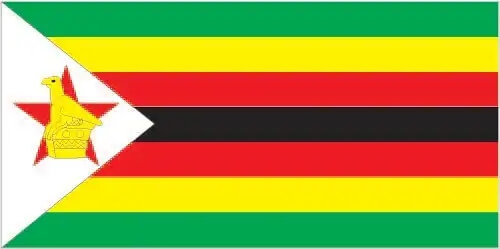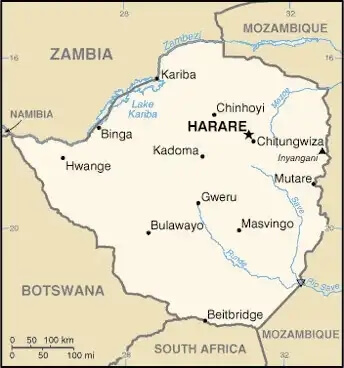World Book
Zimbabwe
World Book Index
46


With a score of 46, the country is ranked 140th out of 158 countries in the World Book ranking. (more information)
Introduction
Background
The Kingdom of Zimbabwe was the largest trading state in the area until the mid-15th century. UK colonization in the late 1800s led to the creation of Southern Rhodesia in 1923. UN sanctions and an uprising led to free elections in 1979 and the creation of an independent country of Zimbabwe in 1980.
Geography
Area
total : 390,757 sq km
land: 386,847 sq km
water: 3,910 sq km
Climate
tropical; moderated by altitude; rainy season (November to March)
Natural resources
coal, chromium ore, asbestos, gold, nickel, copper, iron ore, vanadium, lithium, tin, platinum group metals
People and Society
Population
total: 17,150,352 (2024 est.)
Ethnic groups
African 99.6% (predominantly Shona; Ndebele is the second largest ethnic group), other (includes Caucasian, Asiatic, mixed race) 0.4% (2022 est.)
Languages
Shona (official, most widely spoken) 80.9%, Ndebele (official, second most widely spoken) 11.5%, English (official, traditionally used for official business) 0.3%, 13 minority languages (official; includes Chewa, Chibarwe, Kalanga, Koisan, Nambya, Ndau, Shangani, sign language, Sotho, Tonga, Tswana, Venda, and Xhosa) 7%, other 0.3% (2022 est.)
Religions
Apostolic Sect 40.3%, Pentecostal 17%, Protestant 13.8%, other Christian 7.8%, Roman Catholic 6.4%, African traditionalist 5%, other 1.5% (includes Muslim, Jewish, Hindu), none 8.3% (2022 est.)
Population growth rate
1.91% (2024 est.)
Government
Government type
presidential republic
Capital
name: Harare
Executive branch
chief of state: President Emmerson Dambudzo MNANGAGWA (since 4 September 2023)
head of government: Vice President Constantino CHIWENGA (since 11 September 2023)
Diplomatic representation in the US
chief of mission: Ambassador (vacant); Chargé d'Affaires Sarah BHOROMA (since 12 November 2024)
Diplomatic representation from the US
chief of mission: Ambassador Pamela M. TREMONT (since August 2024)
Economy
Economic overview
low income Sub-Saharan economy; political instability and endemic corruption have prevented reforms and stalled debt restructuring; new Zimbabwe Gold (ZiG) currency latest effort to combat ongoing hyperinflation; reliant on natural resource extraction, agriculture and remittances
Real GDP (purchasing power parity)
$57.391 billion (2024 est.)
$56.249 billion (2023 est.)
$53.399 billion (2022 est.)
Real GDP per capita
$3,500 (2024 est.)
$3,400 (2023 est.)
$3,300 (2022 est.)
Exports
$7.603 billion (2023 est.)
$7.453 billion (2022 est.)
$6.575 billion (2021 est.)
Exports - partners
UAE 45%, China 18%, South Africa 15%, Mozambique 4%, Hong Kong 2% (2023)
Exports - commodities
gold, tobacco, nickel, minerals, diamonds (2023)
Imports
$10.293 billion (2023 est.)
$9.569 billion (2022 est.)
$8.104 billion (2021 est.)
Imports - partners
South Africa 37%, China 15%, Bahamas, The 5%, Singapore 5%, UAE 4% (2023)
Imports - commodities
refined petroleum, fertilizers, trucks, soybean oil, stone processing machines (2023)
Human Development Index
The country's Human Development Index (HDI) is 0.598, ranking it 153rd out of 193 countries tested. (more information)
World Happiness Report
The World Happiness Report ranked the country 154th out of 158 countries tested with a score of 3.295. (more information)



